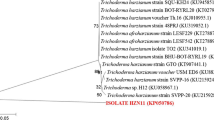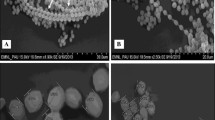Abstract
Fungi isolated from partially decayed wood log samples showing characteristic diversity for spore colour, colony morphology and arrangement of spores were assessed for cellulolytic enzyme production. Isolates showing a cellulolytic index of ≥2.0 were assayed for filter paper (FP) cellulase and β-glucosidase (BGL) production. Molecular characterization confirmed the identity of the selected cellulolytic isolate as a strain of Aspergillus niger (A. niger HN-2). Addition of 2 % (w/v) urea enhanced FP and BGL activity by about 20 and 60 %, respectively. Validation studies conducted at parameters (29 °C, pH 5.4, moisture content 72 % and 66 h) optimized through response surface methodology in a solid-state static tray fermentation resulted in FP, BGL, cellobiohydrolase I (CBHI), endoglucanase (EG), xylanase activity and protein content of 25.3 FPU/g ds, 750 IU/g ds, 13.2 IU/g ds, 190 IU/g ds, 2890 IU/g ds and 0.9 mg/ml, respectively. In comparison, A. niger N402 which is a model organism for growth and development studies, produced significantly lower FP, BGL, CBHI, EG, xylanase activity and protein content of 10.0 FPU/g ds, 100 IU/g ds, 2.3 IU/g ds, 50 IU/g ds, 500 IU/g ds and 0.75 mg/ml, respectively under the same process conditions as were used for A. niger HN-2. Process optimization led to nearly 1.8- and 2.2-fold increase in FP and BGL activity, respectively showing promise for cellulase production by A. niger HN-2 at a higher scale of operation. Zymogram analysis revealed two isoforms each for EG and cellobiohydrolase and three isoforms for BGL. Crude cellulase complex produced by A. niger HN-2 exhibited thermostability under acidic conditions showing potential for use in biofuel industry.







Similar content being viewed by others
References
Aguiar CL (2001) Biodegradation of the cellulose from sugar cane bagasse by fungal cellulase. Ciˆencia e Tecnologia de Alimentos 3:117–121
Aiba S, Humphrey AE, Millis NF (1973) Kinetics. In: Biochemical Engineering. 2nd edn. New York, Academic Press, pp 92–127
Bailey MJ, Tahtiharju J (2003) Efficient cellulose production by Trichoderma reesei in continuous cultivation on lactose medium with a computer-controlled feeding strategy. Appl Microbiol Biotechnol 62:156–162
Bansal N, Tewari R, Soni R, Soni SK (2012) Production of cellulases from Aspergillus niger NS-2 in solid state fermentation on agricultural and kitchen waste residues. Waste Manag 32:1341–1346
Bhat MK (2000) Cellulases and related enzymes in biotechnology. Biotechnol Adv 18:355–383
Botella C, de Ory I, Webb C, Cantero D, Blandino A (2005) Hydrolytic enzyme production by Aspergillus awamori on grape pomace. Biochem Eng J 26:100–106
Bradford MM (1976) A rapid and sensitive method for the quantification of microgram quantities of protein utilizing the principle of protein-dye binding. Anal Biochem 72:248–254
Brijwani K, Vadlani PV (2011) Cellulolytic enzymes production via solid-state fermentation: effect of pretreatment methods on physicochemical characteristics of substrate. Enzym Res. doi:10.4061/2011/860134
Brijwani K, Oberoi HS, Vadlani PV (2010) Production of a cellulolytic enzyme system in mixed-culture solid-state fermentation of soybean hulls supplemented with wheat bran. Process Biochem 45:120–128
Chinedu SN, Nwinyi OC, Okochi VI (2008) Growth and cellulose activity of wild-type Aspergillus niger ANL301 in different carbon sources. Can J Pure Appl Sci 2:357–362
Dhillon GS, Oberoi HS, Kaur S, Bansal S, Brar SK (2011) Value addition of agricultural wastes for augmented cellulase and xylanase production through solid-state tray fermentation employing mixed-culture of fungi. Ind Crops Prod 34:1160–1167
Dhillon GS, Kaur S, Brar SK, Verma M (2012) Potential of apple pomace as a solid substrate for fungal cellulase and hemicellulase bioproduction through solid state fermentation. Ind Crops Prod 38:6–13
Ghose TK (1987) Measurement of cellulase activities. Pure Appl Chem 59:257–268
Gielkens MM, Dekkers E, Visser J, Graaff LH (1999) Two cellobiohydrolase-encoding genes from Aspergillus niger require D-xylose and the xylanolytic transcriptional activator XInR for their expression. Appl Environ Microbiol 65:4340–4345
Gowthaman MK, Raghava Rao KSMS, Ghildyal NP, Karnath N (1993) Gas concentration and temperature gradient in a packed bed solid state fermenter. Biotechnol Adv 11:611–620
Gwande PV, Kamat MY (1999) Production of Aspergillus xylanase by lignocellulosic waste fermentation and its application. J Appl Microbiol 87:511–519
He H, Qin Y, Chen G, Nan L, Liang Z (2013) Two-step purification of a novel β-glucosidase with high transglycosylation activity and another hypothetical β-glucosidase in Aspergillus oryzae HML366 and enzymatic characterization. Appl Biochem Biotechnol. doi:10.1007/s12010-012-9936-9
Holker U, Hofer M, Lenz J (2004) Biotechnological advantages of laboratory scale solid-state fermentation with fungi. Appl Microbiol Biotechnol 64:175–186
Jatinder K, Chadha BS, Saini HS (2006) Optimization of medium components for production of cellulase by Melanocarpus sp. MTCC 3922 under solid state fermentation. World J Microbiol Biotechnol 22:15–22
Javed MR, Rashid MH, Nadeem H, Riaz M, Perveen R (2009) Catalytic and thermodynamic characterization of endoglucanase (CMCase) from Aspergillus oryzae cmc-1. Appl Biochem Biotechnol 157:483–497
Job J, Sukumaran RK, Jayachandran K (2010) Production of a highly glucose tolerant β-glucosidase by Paecilomyces variotii MG3: optimization of fermentation conditions using Plackett–Burman and Box-Behnken experimental designs. World J Microbiol Biotechnol 26:1385–1391
Juwaied AA, Al-amiery AAH, Abdumuniem Z, Anaam U (2011) Optimization of cellulase production by Aspergillus niger and Tricoderma viridae using sugar cane waste. J Yeast Fungal Res 2:19–23
Kasana RC, Salwan R, Dhar H, Dutt S, Gulati A (2008) A rapid and easy method for the detection of microbial cellulases on agar plates using Gram’s Iodine. Curr Microbiol 57:503–507
Kaur B, Sharma M, Soni R, Oberoi HS, Chadha BS (2013) Proteome-based profiling of hypercellulase-producing strains developed through interspecific protoplast fusion between Aspergillus nidulans and Aspergillus tubingensis. Appl Biochem Biotechnol 169:393–407
Klein-Marcuschamer D, Oleskowicz-Popiel P, Simmons BA, Blanch HW (2012) The challenge of enzyme cost in the production of lignocellulosic biofuels. Biotechnol Bioengg 109:1083–1087
Lee CK, Darah I, Ibrahim CO (2011) Production and optimization of cellulase enzyme using Aspergillus niger USM AI 1 and comparison with Trichoderma reesei via solid state fermentation system. Biotechnol Res Int. doi:10.4061/2011/658493
Maeda RN, da Silva MMP, Santa Anna LLM, Pereira JN (2010) Nitrogen source optimization for cellulase production by Penicillium funiculosum using a sequential experimental design methodology and the desirability function. Appl Biochem Biotechnol 161:411–422
Niranjane AP, Madhou P, Stevenson TW (2007) The effect of carbohydrate carbon sources on the production of cellulase by Phlebia gigantean. Enzym Microbial Technol 40:1464–1468
Oberoi HS, Sandhu SK, Vadlani PV (2012) Statistical optimization of hydrolysis process for banana peels using cellulolytic and pectinolytic enzymes. Food Bioprod Process 90:257–265
Pushalkar S, Rao KK, Menon K (1995) Production of beta-glucosidase by Aspergillus terrus. Curr Microbiol 30:255–258
Reddy AS, Reddy SM (1985) Production of extracellular cellulase-hemicellulase complex by Macrophomina phaseolina, the seed rot fungus of Sesame (Sesamum indicum). J Indian Bot Soc 64:377–380
Sandhu SK, Oberoi HS, Dhaliwal SS, Babbar N, Kaur U, Nanda D, Kumar D (2012) Ethanol production from Kinnow mandarin (Citrus reticulata) peels via simultaneous saccharification and fermentation using crude enzyme produced by Aspergillus oryzae and the thermotolerant Pichia kudriavzevii strain. Ann Microbiol 62:655–666
Saqib AAN, Hassan M, Khan FK, Baig S (2010) Thermostability of crude endoglucanase from Aspergillus fumigatus grown under solid state fermentation (SSF) and submerged fermentation (SmF). Process Biochem 45:641–664
Senthilkumar V, Gunasekaran P (2005) Bioethanol production from cellulosic substrates: engineered bacteria process integration challenges. J Sci Ind Res 64:845–853
Sherief AA, El-Tanash AB, Atia N (2010) Cellulase production by Aspergillus fumigatus grown on mixed substrate of rice straw and wheat bran. Res J Microbiol 5:199–211
Soni R, Nasir A, Chadha BS (2010) Optimization of cellulase production by a versatile Aspergillus fumigatus fresenius strain (AMA) capable of efficient deinking and enzymatic hydrolysis of Solka floc and bagasse. Ind Crops Prod 31:277–283
Sukumaran RK, Singhania RR, Mathew GM, Pandey A (2009) Cellulase production using biomass feed stock and its application in lignocellulose saccharification for bio-ethanol production. Renew Energy 34:421–424
Szengyel Z, Zacchi G, Varga A, Reczey K (2000) Cellulase production of Trichoderma reesei Rut-30 using steam-pretreated spruce. Hydrolytic potential of cellulases on different substrate. Appl Biochem Biotechnol 84:679–691
Tamura K, Dudley J, Nei M, Kumar S (2007) MEGA 4: molecular evolutionary genetics analysis (MEGA) software version 4.0. Mol Biol Evol 24:1596–1599
Teather RM, Wood PJ (1982) Use of congo red polysaccharide interactions in enumeration and characterization of cellulolytic bacteria from the bovine rumen. Appl Environ Microbiol 43:777–780
Urbanszki K, Szakacs G, Tengerdy RP (2000) Standardization of filter paper activity assay for solid substrate fermentation. Biotechnol Lett 22:65–69
Uusitalo JM, Nevalainen KM, Harkki AM, Knowles JK, Penttila ME (1991) Enzyme production by recombinant Trichoderma reesei strains. J Biotechnol 17:35–49
Warren RAJ (1996) Microbial hydrolysis of polysaccharides. Annu Rev Microbiol 50:183–212
Willick GE, Seligy VL (1985) Multiplicity in cellulases of Schizophyllum commune. Eur J Biochem 151:89–96
Yano KS, Poulos TL (2003) New understandings of thermostable, peizostable enzymes. Curr Opin Microbiol 14:360–365
Zabel RA, Morrell JJ (1992) Wood microbiology, decay and its prevention. Academic Press, San Diego, p 476
Zaldivar J, Nielsen J, Olsson L (2001) Fuel ethanol production from lignocellulose: a challenge for metabolic engineering and process integration. Appl Microbiol Biotechnol 56:17–34
Zhang H, Sang Q, Zhang W (2012) Statistical optimization of cellulases production by Aspergillus niger HQ-1 in solid-state fermentation and partial enzymatic characterization of cellulases on hydrolyzing chitosan. Ann Microbiol 62:629–645
Acknowledgments
Authors thankfully acknowledge the financial assistance received under the NAIP Project (418301-3) funded by World Bank from the Indian Council of Agricultural Research, New Delhi, India for conducting this study.
Author information
Authors and Affiliations
Corresponding author
Rights and permissions
About this article
Cite this article
Oberoi, H.S., Rawat, R. & Chadha, B.S. Response surface optimization for enhanced production of cellulases with improved functional characteristics by newly isolated Aspergillus niger HN-2. Antonie van Leeuwenhoek 105, 119–134 (2014). https://doi.org/10.1007/s10482-013-0060-9
Received:
Accepted:
Published:
Issue Date:
DOI: https://doi.org/10.1007/s10482-013-0060-9




